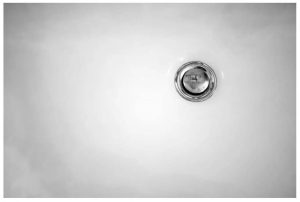How To Remove A Delta Sink Stopper

Included in many Delta faucet kits is a sink stopper. When installed correctly, the stopper allows you to close the drain by pulling up on the lever behind the faucet and trapping the water in the sink. Once you decide you want to drain the sink, you can push the lever down to open the drain and let the water run down the drain.
However, over the years, plugs can catch all sorts of things, such as hair, dirt and other debris. Removing the buildup isn’t difficult, but you will need to get up close and personal with the sink drain. If you need to clean out a sink stopper in your home, read on for a quick how-to guide on how to remove a Delta sink stopper.
How Does It Work?
To better understand how to properly remove a Delta sink stopper, we’ll look at the parts that make up the assembly and how they work. Most pop-up drains have a lever behind the body of the faucet. The plug contains several major components including a lift lever, clevis, horizontal pivot lever and a drain tailpiece.
The lift lever is what you see sticking out behind the body of the faucet. It is connected to the horizontal pivot rod by a clevis, which is a slotted rod. The pivot rod extends into the end of the drain and passes through a hook located at the bottom of the plug.
To remove the plug, you must disengage each component, including the pivot rod, from the hook. However, to do this, you must disconnect the entire plug linkage. This sounds like a lot of work, but if you have a few minutes to do this project, you should have no problem.
How To Remove A Delta Sink Plug
Before you start removing the sink plug, you will need a few things, including.
- Screwdriver
- Pliers
- Headlamp
Start by cleaning out the sink cabinet so that you have enough room to work. Next, you will need the help of a headlamp to determine the position of the chuck. It will be attached to the lift rod by a screw. Using your screwdriver or pliers, remove the screw and pull the clevis off of the pivot bar.
There will be a spring clip to prevent the collet from sliding out of position. To remove the collet, squeeze the collet and slide it off the rod so that the collet can move freely.

Next, remove the pivot rod. It is held on the tailplane by a retaining nut. Use pliers to loosen and remove the nut, then remove the pivot rod from the tailpiece. Now you can remove the plug and take it out of the drain tube.
While you have the plug out, it doesn’t hurt to use the hair clog removal tool to pull out any gunk or hair that is clogging the drain. Add drain cleaning fluid to the back of the removal tool. This is not necessary to remove the plug, but again, since you have the plug out of the drain, you might as well clean the drain before you put everything back in place.
If you want to use a homemade drain cleaner instead of detergent, you can make your own mixture at home. Mix together ½ cup of baking soda and ¼ cup of table salt. Pour it into the drain in question. Add 1 cup of warm vinegar to the mixture. Note that the vinegar will make the baking soda and salt mixture froth.
Seal the drain with a stopper or pipe tape to prevent the mixture from flowing out. Let it sit for fifteen minutes and then flush it with hot water.
It’s also a good idea to clean the stopper while you’re taking it out. You can use an old toothbrush or cleaning brush and bathroom cleaner or vinegar to scrub the plug.
How To Remove A Stuck Sink Plug
Sometimes, a sink can become so clogged that it can’t be moved or gets stuck in a semi-closed position, making the water drain very slowly. In either case, it can be very frustrating. Fortunately, the sink plug mechanism is not particularly complicated, so solving the problem is relatively simple.
First, when you pull up or push down on the lift lever, check to see if the plug moves. If the plug stays still, then something is likely unhooked in the mechanism under the sink.
Look under the sink to make sure the mechanism is connected the right way: verify that the horizontal pivot rod, lift rod and tailpiece are connected as specified. If there are any disconnects anywhere, you have likely found your problem.
 ARCORA FAUCETS
ARCORA FAUCETS